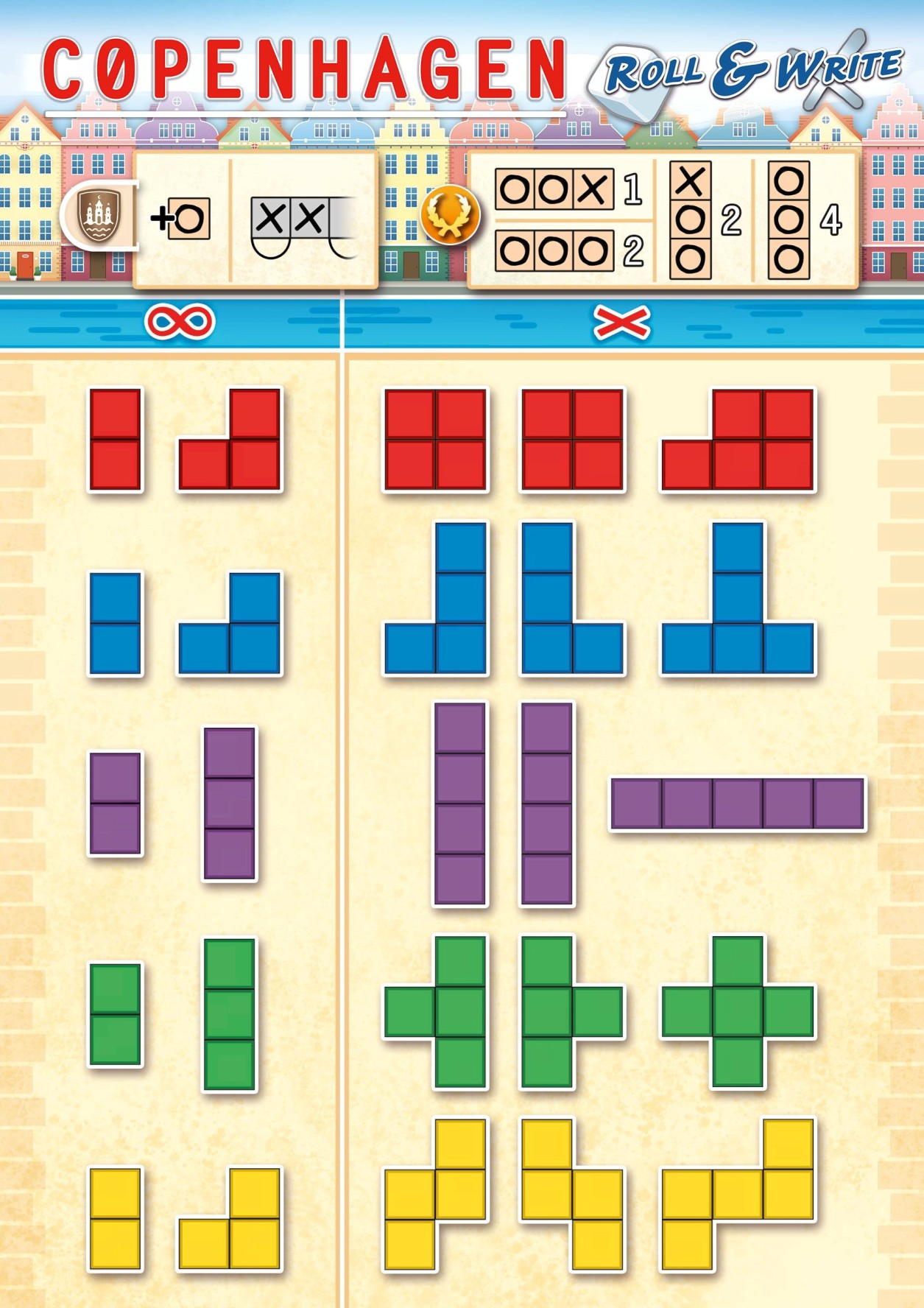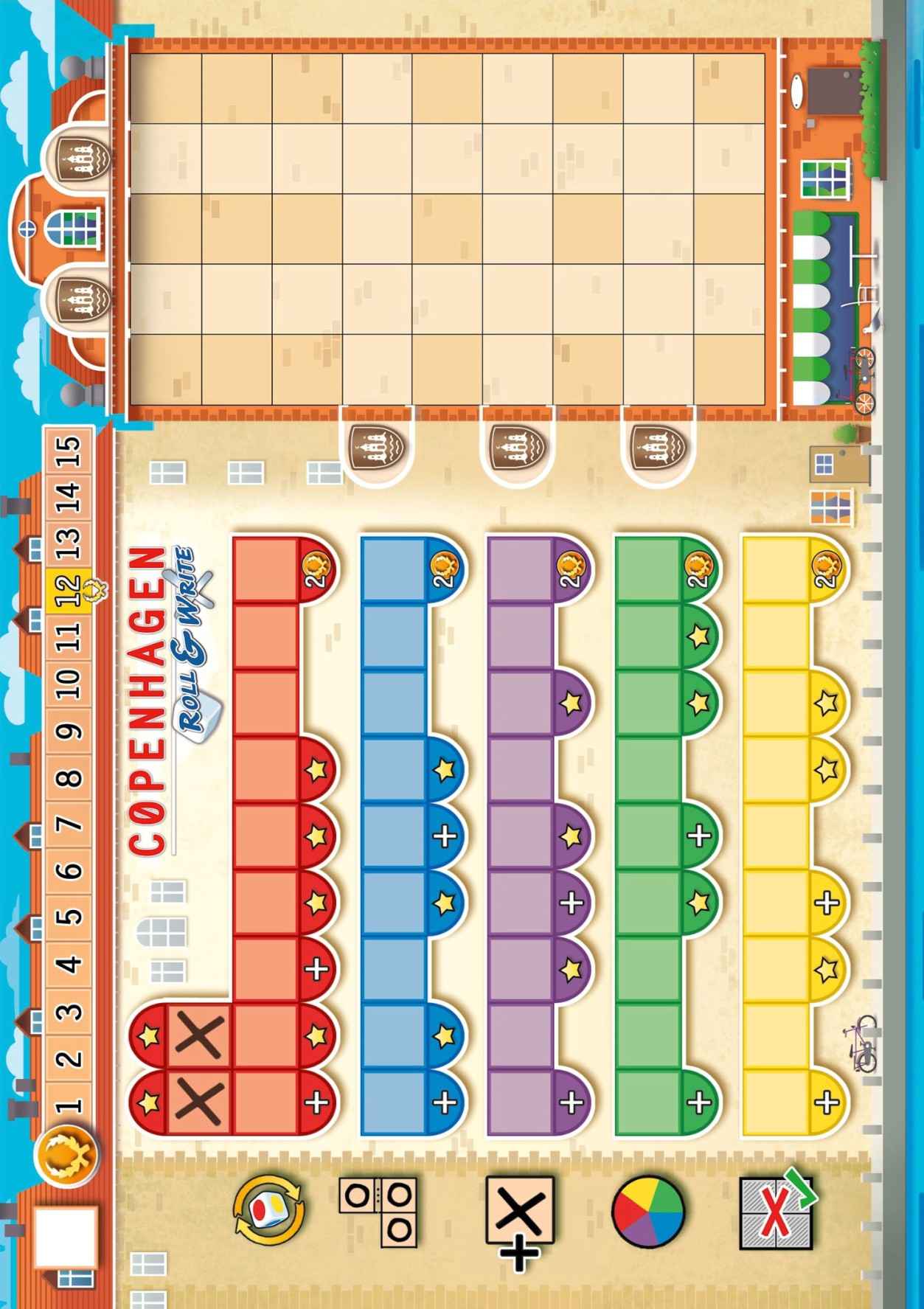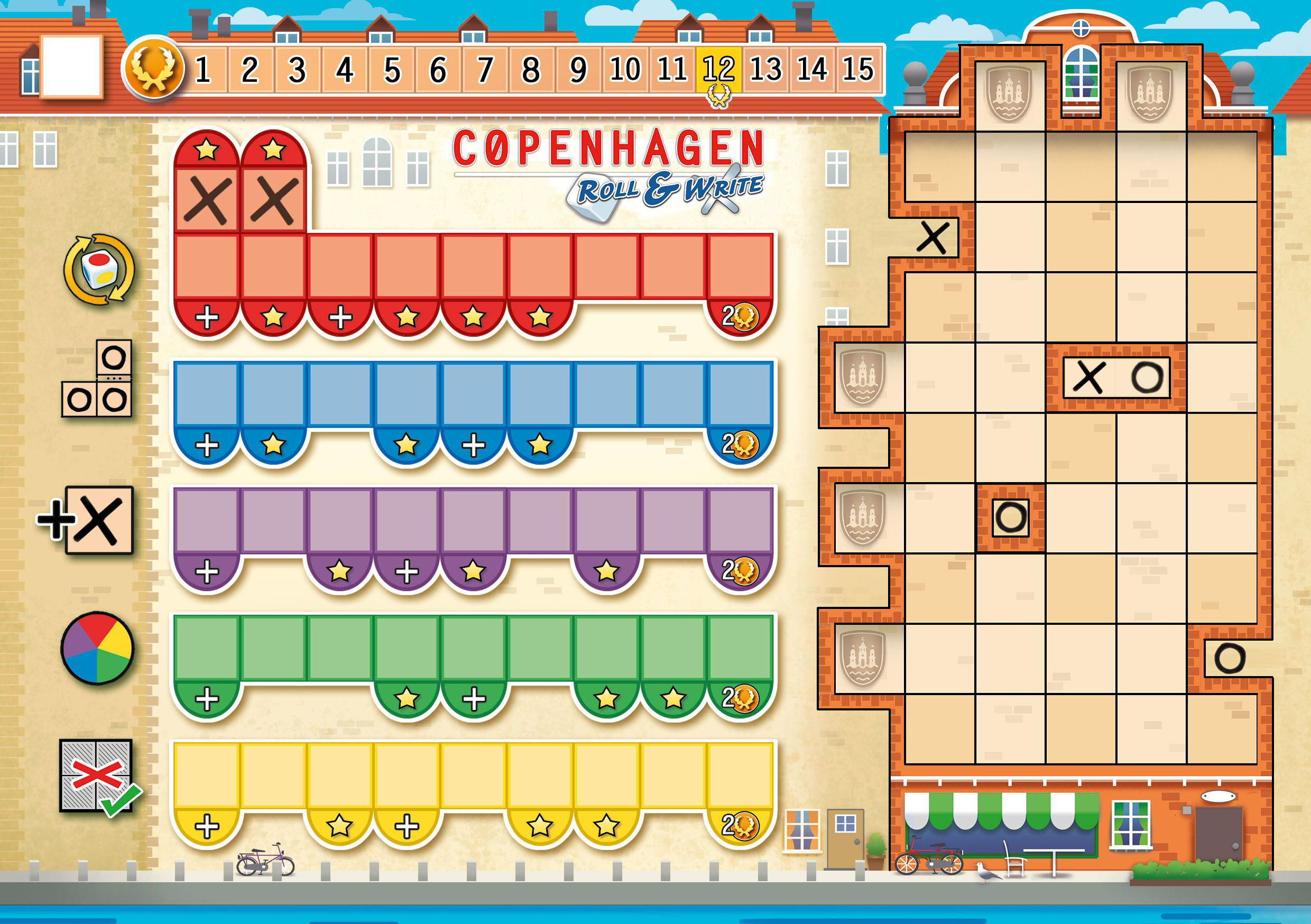
5 Dice
Copenhagen English Color Dot Dice
Roll & Write
Jeux
Dice Game
Game idea and goal of the game
The Danish city of Copenhagen is famously traversed by canals and harbours. On one of these harbors lies “Nyhavn” (New Harbor) with its colorful gabled houses.
Players are tasked to finish the facades of new buildings on the waterfront.
On a turn, one player will roll dice and use one of the colors rolled to draw building pieces, scoring points whenever they complete a row or column.
Other players may use the unused dice to unlock special abilities they can use on future turns.
The player who reaches 12 points first triggers the last round and the winner will be the player who has the most points at the end of that last round.
Components & Set-up
Block of Player Sheets

5 Dice

Block of Facade sheets

1 Rules booklet
Place one sheet from the facade block in the middle of the table and the dice next to it.
Then, each player will take one sheet from the player block and place it in front of them. Each player will also need a pen (not included).
The youngest player starts the game and marks the start player box with an X.
1 Player Sheet
Start player box – An X here marks which player is the starting player of this game.

Scoring track – Points are marked by drawing X’s in the squares every time the player finishes a row or column.

Ability tracks – The squares of the tracks are fi lled from left to right by drawing an X in them.
As soon as an X is drawn above a bonus (  ) or an
ability (
) or an
ability ( ), the player is able to use it on their
turn.
), the player is able to use it on their
turn.
Bonuses help the player draw larger facade tiles, while abilities alter the rules of the game to the player’s advantage.
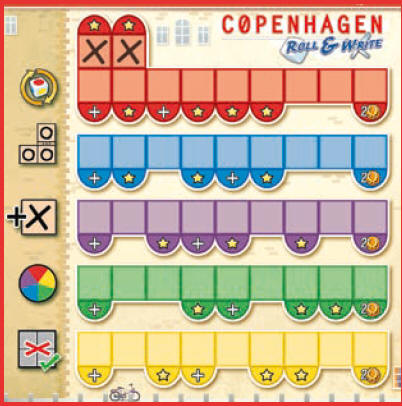
Building – Players will draw the facade tiles they choose from the facade block here on their building.
Blocks must be drawn following the rules, with the goal of completing rows and columns.
With each finished row or column the player will earn points and may unlock a coat-of-arms.
Coats-of-arms – Unlocked by completing a row or a column in the building showing a coat-of-arms.
The player immediately decides to either place a size one facade block (a single O) or mark off two squares of one ability track.

Dice
The different sides show the corresponding facade colors available to the players. The white side (orange on some dice) is wild and represents any of the other five colors.
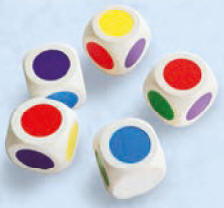
Facade Sheet
Overview ![]() – Shows the
points awarded to players for finishing rows and columns in their building and
the possible bonus actions for unlocking a coat-of-arms.
– Shows the
points awarded to players for finishing rows and columns in their building and
the possible bonus actions for unlocking a coat-of-arms.
Facade tiles ![]() – These are
the shapes players can draw in their buildings in order to complete rows and
columns. The shapes in the infinity column (∞)
can be chosen any number of times, while the shapes in the X column (X)
can only be chosen once, after which they are crossed out.
– These are
the shapes players can draw in their buildings in order to complete rows and
columns. The shapes in the infinity column (∞)
can be chosen any number of times, while the shapes in the X column (X)
can only be chosen once, after which they are crossed out.
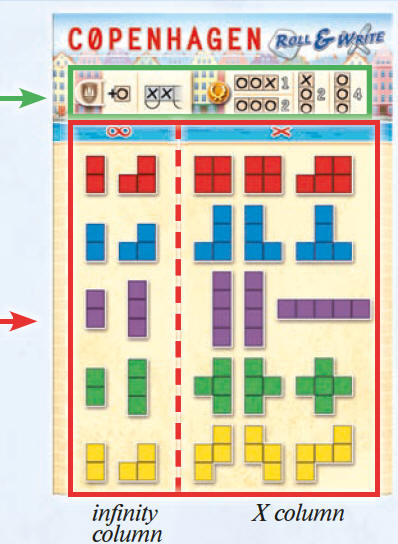
How to play
Copenhagen Roll & Write is played over a series of game rounds.
Play starts with the designated start player and continues clockwise.
A turn consists of three phases:
1. Roll dice and choose a facade shape
2. Draw the facade shape
3. Other players choose an ability track
On their turn, a player may use as many unlocked bonuses and abilities as they desire.
When a player is finished, the dice are passed to the next player clockwise and it becomes their turn.
All players will take the same number of turns in a game.
The game ends after the round in which at least one player reaches 12 or more points on the score track. The player with the most points is the winner.
A Turn in Detail
1. Roll dice and chose a facade shape
The active player rolls all 5 dice and then, depending on the die results, chooses a facade shape from the facade block.
In order to choose a facade shape the player has to follow these rules:
a. The number of dice that show the same color has to match the number of squares and color of the chosen facade shape.
Note: The player is allowed to take a facade shape with fewer squares than matching colors of the dice.
b. The facade tile must be available, meaning be either a tile from the infinity column (∞ ) or not be crossed out in the X column (X).
The player may choose which color they would like the die faces that show a white side to be.
If the chosen shape is picked from the X column (X), the player crosses out the shape.
This tile may no longer be chosen by any player.
2. Draw the facade shape The chosen facade shape is drawn onto the building using the following rules.
Example:
Three dice show red. The player now may choose either a red 2-square or a red 3-square facade shape.
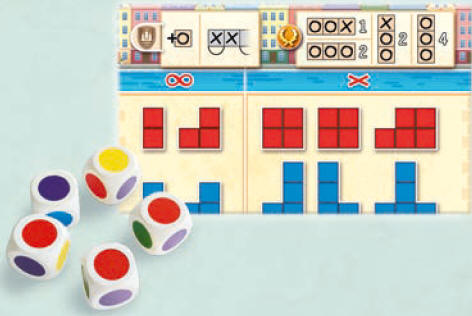
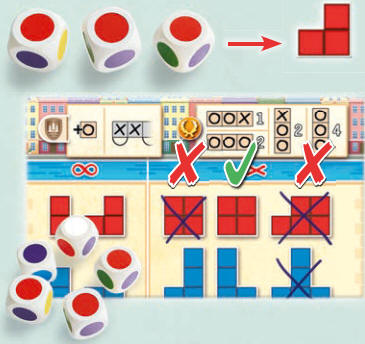

Drawing rules:
a. The shape may be drawn rotated in any direction, but must able to fi t on the grid.
b. A shape must be placed on the bottom row, or such that at least one square is directly above a previously placed shape. Only one square is needed to be above the old shape. (see examples)
c. After drawing the shape in the desired location, one of the squares of the shape has to be marked with an X.
The other squares of the shape are marked with an O.
The player may choose which square to mark with an X.

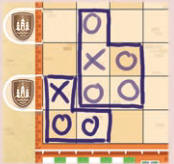
Scoring points and unlocking coats-of-arms
If a player completes a row or a column in their building, points are awarded as follows:
Row:
1 point if the row contains at least one X.
2 points if the row is made up of only O’s.
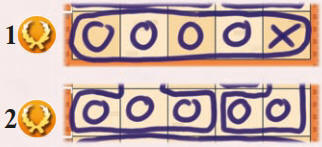
Column:
2 points if the column contains at least one X.
4 points if the column is made up of only O’s.
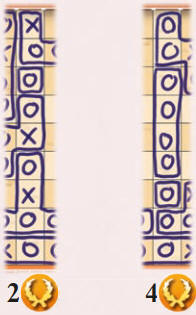
Unlocking coats-of-arms:
A player unlocks a coat-of-arms if they have managed to complete a row or column with an attached coat-of- arms.
If they have done so, they cross it off and immediately choose one of the two special actions:
a. The player draws one square, following the drawing rules, in their building and marks it with an O.
If this completes a row or column score it immediately. If it unlocks another coat-of-arms, the player immediately gets to take another special action.
b. The player marks off two squares on one ability track of their choice. They cannot mark from two different tracks.
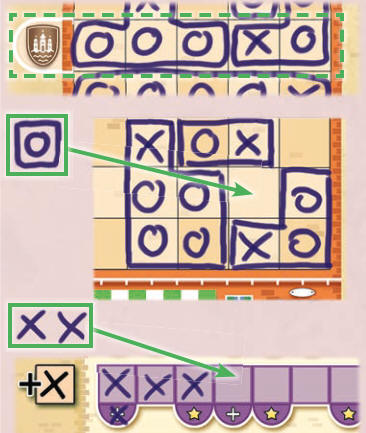
3. Other players choose an ability track All other players choose one unused die of the active player and mark the next square of the corresponding ability track with an X.
The non- active players may choose the same die.
If a white die remains unused, each non-active player may mark off an ability track of their choice.
If the active player used all their dice, the other players cannot mark a square this turn.
The ability tracks are marked from left to right. If an X is drawn above a
bonus ( ) or an ability (
) or an ability ( )
the player unlocks it and it may be used on a subsequent turn.
)
the player unlocks it and it may be used on a subsequent turn.
Example:
The active player uses the three red dice. The other players may now choose between the yellow and purple dice.


If an ability track is fully marked the player immediately gains two points.
When a bonus or ability is used, the player crosses it out and it may not be used again.

Bonus ( )
)
Bonuses act as an extra die of the corresponding color when marked out, thus allowing the player to place the next larger size shape on their building.
Important: A player may only use up to two unlocked bonuses of the same color on their turn.
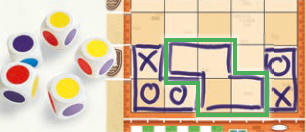

Ability ( )
)
Abilities alter the rules of the game and give the active player an advantage.

What the abilities do and when to use them is explained in detail on the last page of the rules.
End of the game
The game ends at the end of a round in which one player has reached or exceeded 12 points.
Players will compare their final scores, and the highest score is the winner. In case of a tie, the players count the empty squares in their building
The player with the fewest empty squares is declared the winner. If the tie still persists then players will share the victory.
Abilities ( )
)
Abilities may be used only on a player’s own turn. If an ability is used, one ability symbol ( ) on the corresponding track is crossed out.
A player may use multiple abilities on a turn, provided they have unlocked all the abilities that they want to use.
The abilities alter the rules of the game as follows:
Re-Roll
Before the player choses a facade tile to draw, they may choose any number of dice and reroll them once.
The reroll ability can be used multiple times in a turn, but for each roll, a star symbol has to be crossed out.
Each player starts the game with two rerolls already unlocked, which may be used immediately from the start of the game.

No X
When drawing the facade tile, the player may fi ll the entire shape with O’s (i.e. they do not have to mark an X).
Color change
The player may choose as many dice of one color as they like and change the face to a single different color of their choice.
The two yellow dice are turned into red to have 4 red dice to use.

Use Again
The player may choose a facade shape on the facade block already crossed out to draw in their building (the shape does not need to be crossed out again).
One X
After the player draws their tile, they may place a single size one tile anywhere where it may be legally drawn, marking it with an X. Note: If the player also uses the “No X”: ability, any single tiles placed this turn also receive an O instead of an X.
Two player rules
Changes during Set-up Cross out one of the size 4 tiles in each color, and each player marks off the first two squares on one ability track of their choice.
Changes during game play
Other players choose an ability track The non-active player may choose two unused dice and mark the corresponding ability tracks.
The chosen dice may be of the same color.
